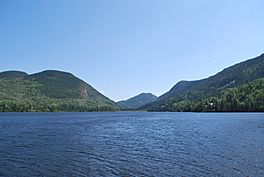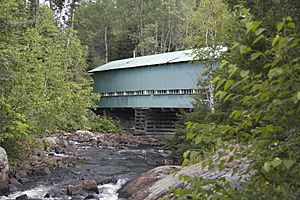Petit lac Ha! Ha! facts for kids
Quick facts for kids Petit lac Ha! Ha! |
|
|---|---|

Surroundings of the lake and view of the Mount Four
|
|
| Lua error in Module:Location_map at line 420: attempt to index field 'wikibase' (a nil value). | |
| Location | Saguenay–Lac-Saint-Jean, Quebec / Le Fjord du Saguenay Regional County Municipality / Ferland-et-Boilleau, Quebec |
| Type | Natural |
| Primary inflows | Creek Quiscane (coming from North and extying lake Huard) and an unidentified creek (coming from east) |
| Primary outflows | Lake Ha! Ha! |
| Basin countries | Canada |
| Max. length | 4.9 km (3.0 mi) |
| Max. width | 1.2 km (0.75 mi) |
| Surface elevation | 381 m (1,250 ft) |
| Settlements | Ferland-et-Boilleau, Quebec |
The Petit lac Ha! Ha! is a beautiful freshwater lake in Quebec, Canada. It's located in the Ferland-et-Boilleau area, which is part of the Saguenay–Lac-Saint-Jean region. This lake sits just east of the larger Lake Ha! Ha!, and its water flows into that lake.
A road called Route 381 runs along the southern part of the lake. This road even crosses a small peninsula that sticks out from the north shore. The amazing views of Petit lac Ha! Ha! and the mountains around it make it a popular spot for people who love nature.
The main way people make a living here is through forestry, which means working with trees and forests. After that, tourism, where people visit for fun, is also important.
The lake usually freezes over from late November until early April. The ice is typically thick enough for safe activities from mid-December to late March.
Exploring the Geography of Petit lac Ha! Ha!
This lake is found about 2.6 kilometres (1.6 mi) southwest of the peak of Mount Four. That mountain is quite tall, reaching an altitude of 822 metres (2,697 ft).

Many streams and rivers flow near Petit lac Ha! Ha!. Here are some of the main ones:
- North side: Quiscale Creek, Huard Lake, Cedar River, Cedar Lake, and Otis Lake.
- East side: Malbaie River and Cabin Creek.
- South side: Malbaie River, Michta Lake, Ha! Ha! River, Cruche River, and Barley River.
- West side: rivière à Pierre, Ha! Ha! River, Lake Ha! Ha!, and rivière à Mars.
Petit lac Ha! Ha! is about 4.9 kilometres (3.0 mi) long. It's nestled between mountains and has a hook shape at its western end, where it connects to Lake Ha! Ha!. The lake is about 1.2 kilometres (0.75 mi) wide at its widest point. It sits at an altitude of 381 metres (1,250 ft).
The lake gets its water from Quiscane Stream, which flows from the north and drains Huard Lake. Another stream, which doesn't have a name, also flows into the lake from the east. Petit lac Ha! Ha! has a few smaller areas called coves and bays, including Canots Cove, Creuse Bay, and Lambert Bay.
Where Does the Water Go?
The water from Petit lac Ha! Ha! flows into Lake Ha! Ha!. From there, it travels a long way!
- First, it goes through Lake Ha! Ha! for about 6.8 kilometres (4.2 mi) to a dam.
- Then, it flows down the Ha! Ha! River for about 34.8 kilometres (21.6 mi).
- Next, it crosses the Bay of Ha! Ha! for about 10.7 kilometres (6.6 mi).
- Finally, the water enters the mighty Saguenay River and travels about 87 kilometres (54 mi) east to Tadoussac. At Tadoussac, the Saguenay River joins the huge St. Lawrence River, which eventually flows into the Atlantic Ocean.
The Meaning Behind the Name "Ha! Ha!"
The name "Petit lac Ha! Ha!" is connected to a larger lake, a river, and a bay that all share the "Ha! Ha!" name. You might think it sounds like someone laughing, but the real meaning is a bit more interesting!
Some people think the name comes from an old Montagnais word. This word was hard for French speakers to say. In the Algonquin language, it meant "a place where bark is exchanged." This makes sense because the Baie des Ha! Ha! also has a similar name and is part of the same river system.
Another idea is that the name comes from an old French word, ha-ha. This word described a hidden ditch or wall that was an "unexpected obstacle" on a path. It was a clever way to keep animals in or out without blocking the view.
A dictionary from 1632, written by Gabriel Sagard, listed a Huron word, Háhattey, which meant "road, lane, or address." This also suggests a connection to pathways or travel.
The name "Petit lac Ha! Ha!" was officially recognized on December 5, 1968, by the Commission de toponymie du Québec, which is the organization in Quebec that names places.

